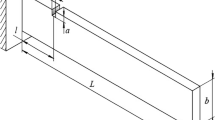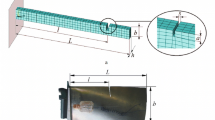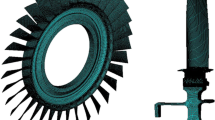The operating life of gas turbine engines is, by and large, dependent on the reliability of compressor rotor blades that are subjected to a complex set of forces of a different nature during their operation, and in particular, to mechanical damage resulting in severe accidents and material losses. The ingress of foreign objects into the air-gas channel of the engine is one of the causes giving rise to blade damage. As a consequence, various marks, dents, dimples, etc., occur on rotor blades changing the designed geometry of the blade airfoil and their natural vibration frequency spectrum and beginning to act as stress concentrators, thus reducing the vibration resistance of blades. The known investigations on the vibration of damaged mechanical systems, including also compressor rotor blades, have an insufficient amount of data on the formation of the spectrum of their natural frequencies typical of their vibration modes with consideration of the influence of a combined change in the elastic and inertia characteristics. The paper deals with a computational and experimental investigation on the influence of local surface damage on the spectrum of natural flexural vibration frequencies of a cantilever rod with a constant cross section as a simplest model of the compressor rotor blade. The regularities in the variation of the natural frequencies of the first to fourth flexural vibration modes of the rods of different flexibility with the geometrical parameters of the notch simulating damage, such as the position along the length and its depth, are presented. The distribution of variations in the natural frequencies of the rods is found to correspond to the location of the nodes of their vibration mode under investigation. The reduction in the frequency of the damaged rod occurs independently of the vibration mode and the depth of the notch when it is located near the rod attachment, while being more significant with the depth of the notch and less pronounced for the higher vibration modes as compared to the first one, which is attributable to the variation in the rod stiffness. The equality of the natural vibration frequencies of the damaged and undamaged rods is observed at a certain position of the notch along the length irrespective of the vibration mode. As the notch approaches the free end of the rod, the natural vibration frequencies become somewhat higher than those for the undamaged rod, since in this case they are more sensitive to the variation in the inertia properties of the rod due to the presence of damage. With the decreasing flexibility, the variation in the natural frequencies of the investigated vibration modes of the damaged rod increases for the same value of the relative damage depth. The results of the performed computations are in a good agreement with the experimental testing data of the rods.





Similar content being viewed by others
References
F. M. Muravchenko and A. V. Sheremet’ev, “Topical problems of dynamics, strength and reliability of modern aircraft engines,” Vibr. Tekhn. Tekhnolog., No. 4 (20), 2–5 (2001).
Yu. A. Nozhnitskii, “Development of the key (critical) manufacturing techniques to create a new generation of gas turbine engines,” in: New Manufacturing Processes and Reliability of GTE [in Russian], Issue 1 (2000), pp. 5–34.
V. T. Troshchenko (Ed.), Load-Bearing Capacity of GTE Rotor Blades under Vibration Loads [in Russian], Naukova Dumka, Kiev (1981).
N. N. Sirotin, Design and Operation, Damaging and Efficiency of Gas Turbine Engines. Fundamentals of Aircraft Engine and Power Plant Design [in Russian] RIA IM-Inform, Moscow (2002).
V. A. Boguslaev, V. K. Yatsenko, and V. F. Pritchenko, Engineering Support and Prediction of the Load-Bearing Capacity of GTE Components [in Russian], Manuscript, Kiev (1993).
V. A. Boguslaev, “Possibility of increasing the service life of damaged blades,” Strength Mater., 24, No. 4, 317–320 (1992).
I. A. Birger and B. F. Balashov, Structural Strength of Materials and Components of Gas Turbine Engines [in Russian], Mashinostroenie, Moscow (1981).
M. Sh. Nikhamkin, L. V. Voronov, I. P. Konev, and I. V. Semenova, “Damage with foreign objects and stress concentration in compressor rotor blades,” in: Reliability and Life of Machines and Structures [in Russian], No. 31 (2008), pp. 126–135.
OST 1-00-304-79. Gas Turbine Engine Blades. Normalization of Compressor Blade Damage form Foreign Object Ingestion [in Russian], Introduced since July 07, 1991.
V. A. Simson, “Operational/design factors determining the intensity of foreign-object damage to turbojet engines,” in: Operation and Repair of Aircraft Equipment [in Russian], Issue 1 (1972), pp. 101–107.
A. M. Sulima and M. I. Evstigneev, Quality of a Surface Layer and the Fatigue Strength of Alloys [in Russian] Mashinostroenie, Moscow (1974).
A. N. Petukhov, Fatigue Resistance of GTE Components [in Russian] Mashinostroenie, Moscow (1993).
M. Krawczuk and W. Ostachowicz, “Damage indicators for diagnostic of fatigue cracks in structures by vibration measurements – a survey,” J. Theor. Appl. Mech., 34, No. 2, 307–326 (1996).
Yu. S. Vorob’ev and M. A. Storozhenko, “Analysis of damaged blade system vibration in turbomachinery,” Aviats.-Kosm. Tekhn. Tekhnol., No. 8 (44), 132–134 (2007).
Yu. S. Vorob’ev, V. N. Romanenko, E. V. Tishkovets, and M. A. Storozhenko, “Damaged turbine blade vibration,” Vibr. Tekhn. Tekhnlog., No. 5 (37), 47–51 (2004).
E. V. Martsenyuk, A. I. Garkusha, and V. S. Chigrin, “Influence of a dent-type defect on the frequency characteristics of compressor rotor blades,” Aviats.-Kosm. Tekhn. Tekhnol., No. 8 (85), 61–65 (2011).
N. A. Shevelev and I. V. Dombrovskii, “Numerical study of the dynamic characteristics of structural elements with shape defects,” Vestn. PGTU. Mekhanika, No. 1, 160–163 (2009).
O. F. Boriskin and V. V. Persiyanov, “Modeling damages of machine parts. Report 1,” Strength Mater., 26, No. 1, 84–88 (1994).
I. G. Tokar’ and A. P. Zinkovskii, “A study of the influence of damage in equitype elements on vibration of regular systems,” Strength Mater., 38, No. 2, 135–140 (2006).
Kaushar H. Barad, D. S. Sharma, Vishal Vyas, “Crack detection in cantilever beam by frequency based method,” Procedia Engineer., 51, 770–775 (2013).
Dong Wei, Yinghua Liu, and Zhihai Xiang, “An analytical method for free vibration analysis of functionally graded beams with edge cracks,” J. Sound Vib., 331, 1686–1700 (2012).
Kamil Aydin, “Free vibration of functionally graded beams with arbitrary number of surface cracks,” Eur. J. Mech. Ser. A-Solid., 42, 112–124 (2013).
A. P. Zinkovskii, I. G. Tokar’, and V. A. Kruts, “Influence of the local surface damage parameters on the natural frequencies of vibration of structural elements,” Strength Mater., 47, No. 2, 211–226 (2015).
G. S. Pisarenko, A. P. Yakovlev, and V. V. Matveev, Handbook on Strength of Materials [in Russian], Naukova Dumka, Kiev (1975).
I. G. Tokar’, A. P. Zinkovskii, A. Ya. Adamenko, et al., “On the assessment of the vibration stress level of pairwise shrouded turbine blades,” Strength Mater., 18, No. 4, 511–515 (1986).
V. A. Karasev, I. D. Kostin, and A. B. Roitman, “Prevention of machine strength failures by vibrodiagnostic methods. 2. Study of vibrodiagnostics for preventing failure of certain gas-turbine engine parts and assemblies,” Strength Mater., 14, No. 12, 1677–1683 (1982).
V. V. Matveev, A. P. Bovsunovskii, and I. G. Tokar’, “Methods of vibration diagnostics of structural elements with cracks,” Vibr. Tekhn. Tekhnol., No. 4 (20), 31–35 (2001).
Author information
Authors and Affiliations
Corresponding author
Additional information
Translated from Problemy Prochnosti, No. 4, pp. 52 – 61, July – August, 2018.
Rights and permissions
About this article
Cite this article
Zinkovskii, A.P., Tokar’, I.G. Influence of Local Surface Damage on the Natural Frequencies of the Higher Modes of Flexural Vibration of Cantilever Rods. Strength Mater 50, 557–564 (2018). https://doi.org/10.1007/s11223-018-0001-y
Received:
Published:
Issue Date:
DOI: https://doi.org/10.1007/s11223-018-0001-y




